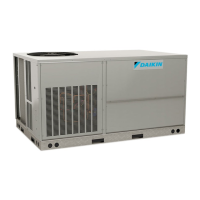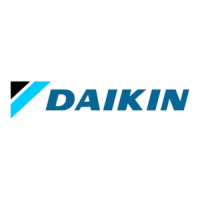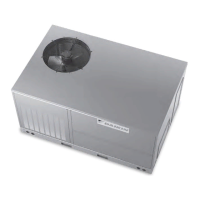SYSTEM OPERATION
13
COOL (HIGH COOL) starts. The blower, both fans, and
both compressors should now be operating. Allow the
unit to run 10 minutes, make sure cool air is being
supplied by the unit.
8. Turn the temperature setting to the highest position,
stopping the unit. The indoor blower will continue to run
for 65 seconds.
9. Turn the thermostat system switch to “OFF” and discon-
nect all power when servicing the unit.
HIGH VOLTAGE!
D
ISCONNECT
ALL
POWER
BEFORE
SERVICING
OR
INSTALLING
THIS
UNIT
. M
ULTIPLE
POWER
SOURCES
MAY
BE
PRESENT
. F
AILURE
TO
DO
SO
MAY
CAUSE
PROPERTY
DAMAGE
,
PERSONAL
INJURY
OR
DEATH
.
WARNING
REFRIGERATION CHECK
The unit is equipped with a thermal expansion valve as a
metering device.
Ensure the hold-down bolts on the compressor are secure
and have not vibrated loose during shipment. Check that
vibration grommets have been installed. Visually check all
piping for damage and leaks; repair if necessary. The entire
system has been factory charged and tested, making it
unnecessary to field charge. Factory charges are shown on
the unit's nameplate. To confirm charge levels or, if a leak
occurs and charge needs to be added to the system, it is
recommended to evacuate the system and recharge refriger-
ate to unit nameplate specifications. This unit has been rated
in the cooling mode at the AHRI rated conditions of: Indoor
(80° db / 67° wb) and outdoor (95° db). While operating at this
condition, the subcooling should range from 12° to 15° F for
each refrigeration circuit, for 15 and 20 ton models. Sucooling
for 25 ton models should be from 16° to 19° F for circuit 1, and
from 12° to 15° F for circuit 2.
FINAL SYSTEM CHECKS
1. Check to see if all supply and return air grilles are
adjusted and the air distribution system is balanced for
the best compromise between heating and cooling.
2. Check for air leaks in the ductwork. See Sections on Air
Flow Adjustments.
3. Make sure the unit is free of “rattles”, and the tubing in the
unit is free from excessive vibration. Also make sure
tubes or lines are not rubbing against each other or sheet
metal surfaces or edges. If so, correct the trouble.
4. Set the thermostat at the appropriate setting for cooling
and heating or automatic change over for normal use.
5. Be sure the Owner is instructed on the unit operation,
filter, servicing, correct thermostat operation, etc.
